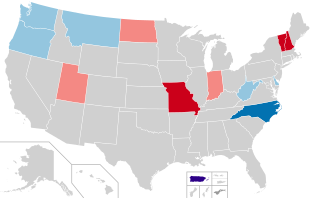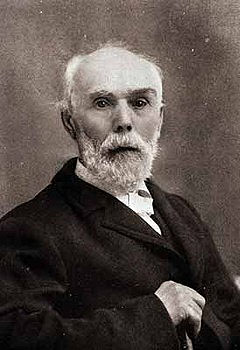| |||||||||||||||||
| |||||||||||||||||
 County results Kitzhaber: 40–50% 50–60% 60–70% Smith: 40–50% 50–60% 60–70% 70–80% | |||||||||||||||||
| |||||||||||||||||
The 1994 Oregon gubernatorial election took place on November 3, 1994. Democratic nominee John Kitzhaber won the election, defeating Republican Denny Smith.
| |||||||||||||||||
| |||||||||||||||||
 County results Kitzhaber: 40–50% 50–60% 60–70% Smith: 40–50% 50–60% 60–70% 70–80% | |||||||||||||||||
| |||||||||||||||||
The 1994 Oregon gubernatorial election took place on November 3, 1994. Democratic nominee John Kitzhaber won the election, defeating Republican Denny Smith.
| Source | Date | John Kitzhaber (D) | Denny Smith (R) |
|---|---|---|---|
| KPTV | September 11, 1994 | 50% | 29% |
Official results are as follows: [1]
| Party | Candidate | Votes | % | |
|---|---|---|---|---|
| Democratic | John Kitzhaber | 622,083 | 50.95% | |
| Republican | Denny Smith | 517,874 | 42.41% | |
| American | Ed Hickam | 58,449 | 4.79% | |
| Libertarian | Danford P. Vander Ploeg | 20,183 | 1.65% | |
| Independent | Write-ins | 2,421 | 0.20% | |
| Total votes | 1,221,010 | 100.00% | ||
| Democratic hold | ||||

The governor of Oregon is the head of government of Oregon and serves as the commander-in-chief of the state's military forces. The title of governor was also applied to the office of Oregon's chief executive during the provisional and U.S. territorial governments.

The 2006 Oregon gubernatorial election took place on November 7, 2006. Incumbent Democratic Governor of Oregon Ted Kulongoski ran for a second and final term as governor. Kulongoski faced several challengers in his primary, whom he dispatched to win his party's nomination a second time, while Republican nominee Ron Saxton, the former Chair of the Portland Public Schools Board and a candidate for governor in 2002 emerged from a crowded primary. Kulongoski and Saxton were initially going to be challenged in the general election by State Senator Ben Westlund, but Westlund withdrew his candidacy before the general election. There were multiple independent and third party challengers on the ballot as well. In a hard-fought campaign, Kulongoski won re-election by a surprisingly wide margin, winning his second term as governor.

The 1994 Alabama gubernatorial election was held on November 8, 1994, to select the governor of Alabama. The election saw Republican Fob James defeat incumbent Democrat Jim Folsom Jr. in an upset. This was the first of three consecutive Alabama gubernatorial elections where the incumbent was defeated. This was one of four gubernatorial elections where the incumbent was defeated in 1994.

On November 8, 1994, gubernatorial elections were held in 36 states and two territories across the United States. Many seats held by Democratic governors switched to the Republicans during the time known as the Republican Revolution. Notably, this marked the first time since 1969 that Republicans secured the majority of governorships in an election cycle.

Elections in Oregon are all held using a Vote by Mail (VBM) system. This means that all registered voters receive their ballots via postal delivery and can vote from their homes. A state Voters’ Pamphlet is mailed to every household in Oregon about three weeks before each statewide election. It includes information about each measure and candidate in the upcoming election.

The 2010 Oregon gubernatorial election was held on Tuesday, November 2, 2010 to elect the Governor of Oregon to a four-year term beginning on January 10, 2011. The incumbent governor, Democrat Ted Kulongoski, was ineligible to run due to term limits barring him from being elected to more than two consecutive terms.

The 1996 United States elections were held on November 5 1996. Democratic President Bill Clinton won re-election, while the Republicans maintained their majorities in both houses of the United States Congress.

The 1990 Oregon gubernatorial election took place on November 7, 1990. Democratic nominee Barbara Roberts defeated Republican David B. Frohnmayer and Independent Al Mobley to win the election.

The 1998 Oregon gubernatorial election took place on November 3, 1998. Democratic nominee John Kitzhaber easily defeated Republican Bill Sizemore to win a second term. Kitzhaber won 35 out of 36 counties, the only county won by Sizemore was Malheur County. This is the only gubernatorial election since 1982 in Oregon in which the margin of victory was in double digits. It is also the most recent election in which any county in Eastern Oregon or Southern Oregon voted for the Democratic nominee, and the most recent gubernatorial election in which a candidate would win while carrying the majority of the state’s counties. Sizemore would run again for governor in the 2022 election, but would lose in the Republican primary.

The 1986 Oregon gubernatorial election took place on November 4, 1986. Democratic nominee Neil Goldschmidt defeated Republican Norma Paulus to win the election. As of 2024, this is the most recent Oregon gubernatorial election in which both major party candidates are now deceased.

The 1970 Oregon gubernatorial election took place on November 3, 1970. In a rematch of the 1966 contest, Republican incumbent Tom McCall defeated Democratic nominee Robert W. Straub to win re-election.

The 1930 Oregon gubernatorial election took place on November 4, 1930 to elect the governor of the U.S. state of Oregon. The Oregon Republican Party, at the time dominant in Oregon politics, initially nominated George W. Joseph, but the nominee died prior to the general election. Joseph's former law partner Julius Meier entered the race as an independent, and defeated replacement Republican nominee Phil Metschan, Jr., Democrat Edward F. Bailey, and Socialist Albert Streiff to become the first and only Independent politician to be elected Governor of Oregon.

The 2014 Oregon gubernatorial election was held on November 4, 2014, to elect the Governor of Oregon, concurrently with other elections in Oregon and across the United States.

United States gubernatorial elections were held on November 8, 2016, in 12 states and two territories. The last regular gubernatorial elections for nine of the 12 states took place in 2012. The last gubernatorial elections for New Hampshire, Oregon, and Vermont took place in 2014, as Oregon held a special election due to the resignation of Governor John Kitzhaber, while the governors of New Hampshire and Vermont both serve two-year terms. The 2016 gubernatorial elections took place concurrently with several other federal, state, and local elections, including the presidential election, Senate, and House elections.

The 1858 Oregon gubernatorial election took place on June 7, 1858, to elect the first governor in anticipation of Oregon statehood. With the state Democratic Party split into factions driven by personal rivalry and state government influence, the election matched insurgent E. M. Barnum against establishment candidate John Whiteaker, who won. The Republican Party first nominated John Denny, but he later withdrew in favor of the insurgent Democrat, whom the party hoped to win over to the Republicans.

United States gubernatorial elections were held on November 8, 2022, in 36 states and three territories. As most governors serve four-year terms, the last regular gubernatorial elections for all but two of the seats took place in the 2018 U.S. gubernatorial elections. The gubernatorial elections took place concurrently with several other federal, state, and local elections, as part of the 2022 midterm elections.

The 2012 OregonSecretary of State election was held on November 6, 2012, to elect the Oregon Secretary of State. Incumbent Democratic Secretary of State Kate Brown ran for a second term against Republican Knute Buehler. Brown and Buehler ran against each other again in the 2018 Oregon gubernatorial election.